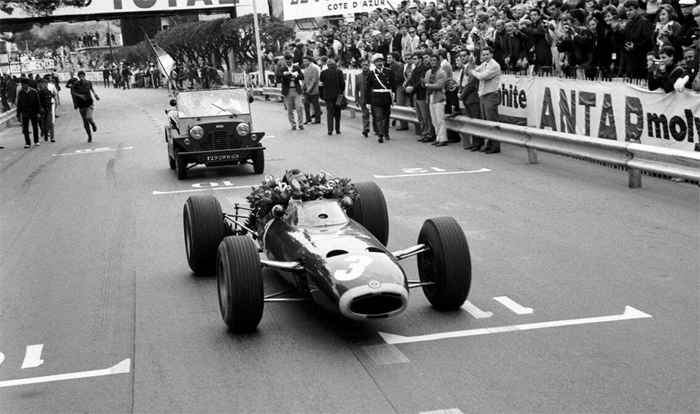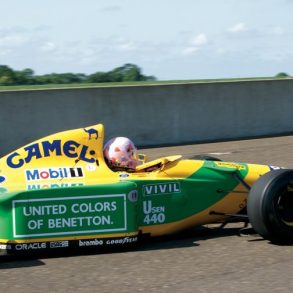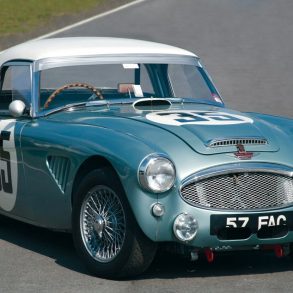1965 Monaco Grand Prix – Graham Hill ‘s Greatest Race
By Graham Hill

Monte Carlo is always a tricky race, one of the trickiest circuits in the world, because it is so easy to be just a little bit untidy at any one particular corner, clobber a kerb with the wheel and break the suspension or break a wheel or cause yourself to spin off. And, of course, there is just nowhere to spin at Monte Carlo; you bounce off hotels, nightclubs, brick walls, telegraph poles, and street lamps. Everything around is absolutely solid, although we have managed to get a few Armco barriers set up at one or two spots which might prevent us from coming to a stop rather smartly.
It’s a proper road circuit and one of the few remaining in the world. You can look at pictures of the first race track – I think it was 1929, the year I was born – and the track looks exactly the same. The only difference is the cars; they are a bit antique looking. The circuit hasn’t altered its shape at all, although the chicane has been moved in the last year to make it just a little bit safer. In fact, if the chicane had been in the right place – in the place where it is now – I wouldn’t have been forced to go up an escape road taking avoiding action during the race in 1965.
The race had been on for about 25 laps and I was in the lead when I came over the brow of a hill towards the chicane. I was doing about 120 mph at that particular point and was just getting on the brakes as I started to go down the hill. As I straightened up and the chicane came into view, I saw Bob Anderson in his Brabham literally creeping down towards the chicane – apparently the car was stuck in first gear. I had seen no flag and no signals or anything. All I could see as I blasted over the hill – in that fleeting second that you get to make a decision – was that he was going to be occupying the chicane at about the time that I wanted to flash through it doing about 95 mph.
There was only one thing to do: I just stood on the brakes as hard as I could, locking them up. I made as if to go through the chicane and I left things until the point of no return, and then I saw that there was just no way I could get through without clobbering him. I came off the brakes for a second so that I could steer and changed direction down the escape road. Then I stood on them again and I left some rare old skid marks. I came to a grinding halt well up the escape road. I had to get out of the car, push it backwards on to the track, climb in, and then start the engine. Well, of course, all this took time and by then the leaders had gone through. I had lost I don’t know how many seconds: about 35. And I had had quite a comfortable lead. Anyway, I lost over half a minute in this operation, which dropped me right back to fifth place. I was pretty narked about this – it had more or less knocked me out of the fight for the lead. So I jumped into the car and set off in hot pursuit.
The race was 100 laps and I had done 25 so I still had three-quarters of the race to make up the time. I was a bit cheesed off over the whole business – if I had come by a second later I would have been able to squeeze through, but as it was I just couldn’t get down to a sufficiently slow pace to follow Anderson through the chicane at his speed. It was bad luck that he just happened to be in that position. There was nothing he could have done about it – he was stuck in first gear. There should really have been a warning – the yellow flag should have been hung out warning the drivers that there was a car proceeding at a slow pace ahead. I would have lifted off a bit earlier and approached the brow of the hill a bit slower; then I would have been able to stop.

First, I caught up my teammate Stewart, who had moved into first place when I went down the escape road, but Stewart had spun at Ste Devote and lost the lead on lap 30. I caught him up and passed him; I set off to catch up Surtees and Bandini who were both driving for Ferrari. They were having a tremendous ding-dong among themselves. Brabham had been after them and had taken the lead on lap 34, but on lap 43 he ran out of oil and had to coast into the pits to retire. I was having a terrific scrap and broke the lap record a number of times – I was motoring faster and faster as the fuel load got lighter. Gradually I got to see this tussle going on and then, of course, the Ferrari team saw that I was closing up. They made frantic efforts to signal to their drivers to stop dicing for the lead and go faster. As soon as Bandini and Surtees got the message from their pit signals that I was catching them up, they started to pull the stops out. By the time I actually caught them up, Bandini had got a bit clear. On lap 53 I got by Surtees and set off after Bandini. I had quite a few goes at passing him.

It takes a lot of planning, a lot of strategy, to actually pass somebody; it just doesn’t occur in a flash if the bloke’s going at roughly the same speed as yourself. You don’t simply say to your-self, ‘Right, I’ll pass him now’; you must build up for it. You probe and you feel; all the time that you are racing against him you are working out where you are going to pass him, where is going to be the best place to pass, where he is a little bit quicker than you and where you are a little bit quicker than he. All these things have to be weighed up and you’ve just got to time it right. Ittakes a lot of working out – unless the fellow makes a mistake; then, of course, you want to be in the right spot when he makes the mistake. If you pressure somebody hard enough he might make a mistake, but then you have still got to be on his tail and in control to take advantage of it. And this is not always possible.
You haven’t just got to make up a car’s length; if you’re right up on his tail – nose to exhaust pipe you have to make up three cars’ lengths to get ahead and allow yourself room to cut in again -which is a lot when it is a tight circuit. You have to follow the leader round the Gasworks turn and round the Station hairpin, so there are very few places to pass. One of the best places for over-taking is after the Gasworks, and it’s the safest, but it requires making a much quicker exit and being sufficiently closed up to be able to pass under acceleration before Ste Devote.

Bandini gave me quite a hard time but eventually I got by him; he didn’t give in, though, and we had a rare old ding-dong. Then Surtees got by Bandini and put the pressure on me for a while around the 80th lap and I know I put in some very fast laps at about this time. It was a tremendous race and I think that this, with the 1962 German Grand Prix, were probably my best races ever. They both had some extraordinary circumstances. (I had had a collision with a cine-camera in practice at Nurburgring.) To have actually won the race at Monte Carlo after having had to push the car back on to the track and then push-start it was quite something. The added pleasure that really put the icing on the cake was the fact it was my hat -trick; it gave me three wins in three consecutive years, which made it even more satisfying and memorable for me.
Surtees was really very unlucky – after an extremely good fight, he had the disappointment of running out of fuel on the last lap and, though he was classified as a finisher in fourth place but one lap behind, it was tragic that he was not able to take second place. Nothing is more galling than to in out of fuel on the last lap; it does make you think that the whole 99 previous laps have been a complete waste of time. When you have really been fighting tooth and nail, to have that sort of thing happen is a very bitter pill indeed. Two hours, 37 minutes, 39-6 seconds is a long time to be motoring flat-out on a circuit like Monte Carlo.

The prize giving itself is a very proper and pukka affair at the Hotel de Paris, which is one of the swankiest hotels in the world, and a very swept-up do. I always somehow managed to for-get to take my dinner jacket and arrived wearing a lounge suit; for three years I have arrived in an ordinary suit and everyone else was wearing a dinner jacket. The trouble is I have noticed since, that when I have taken my dinner jacket I haven’t won the race, so I don’t like to anticipate the victory banquet in this way. Immediately after the race Prince Rainier and Princess Grace received me up on the dais and, of course, they were getting quite used to seeing me; there were a few ‘Not again!’ sort of remarks. They always attend the race and present the awards, and show a lot of interest in the event.
On the night of the race we went to the Tip-Top, a little bar which doesn’t seem to have much to recommend it except that it sells drink, but it is a popular meeting place for all the British contingent – we always go there. I look in every year and every year the owner treats me to a drink – this time it was champagne. After the official prize giving I had my drink and a plate of spaghetti with the owner of the Tip-Top. By this time it was three or four o’clock in the morning and I was starving again: after 100 laps around Monte Carlo it was not very surprising.
I remember Betty and I spent the next day on the beach at Cap Ferrat and I really felt completely relaxed, though that’s hardly the word. I knew that I had taken a lot out of myself mentally and physically, but the victory had really put a glow in me. I don’t think I have ever felt quite like it before. A tremendous feeling of peace, serenity, and fulfillment. I just felt entirely relaxed and every muscle in my body felt as if it was completely rested.
1965 Monaco Grand Prix Results
| 1st | Graham Hill | BRM | 2h 37m 39s |
| 2nd | Lorenzo Bandini | Ferrari | 2h 38m 43.6s |
| 3rd | Jackie Stewart | BRM | 2h 39m 21.5s |













